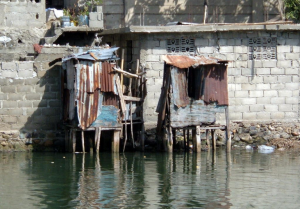The Need

Latrines in Cap Haitien, Haiti (Photo credit: memoireonline.com)
Given population growth and climate change, using clean water to transport sanitary waste, as do virtually all of the world’s centralized sewer systems, is increasingly unsustainable. In California alone, moving and treating 14 trillion gallons of water and waste each year consumes 19% of the state’s electricity, 30% of its natural gas, and 88 billion gallons of diesel fuel. There is growing recognition that source control sanitation methods, as opposed to “end-of-pipe” treatment, will be the only sustainable method for bringing proper sanitation to emerging economies while at the same time offering safe and sustainable alternatives in the developed world.
According to the World Health Organization, 2.5 billion people in the world do not have access to adequate sanitation and 784 million people do not have access to clean drinking water. As a result, 1.7 million people, mostly children under the age of 5, die from diarrheal diseases per year.
Between 1900 and 1995, water use in the world has increased six-fold, much of that increase coming from water transportation of sanitary waste. Economically, the World Health Organization and other authorities show that for countries with per capita GDP of less than $1,000 (some 15% of the world’s population) could not afford to operate centralized water-borne sanitary facilities even if they were given the massively expensive collection and treatment infrastructure free of charge, notwithstanding that sufficient water sources are becoming more scarce, and in many areas, simply not available. In addition, the life-span of typical transportation and treatment facilities is 50-70 years, adding an additional economic burden that is very significant, even in countries like the U.S., where much of the collection infrastructure is well beyond its useful service life.
Conventional household toilets currently use 3 to 5 gallons of water per flush and results in 30% of household water use. The California Energy Commission reports that Northern California wastewater treatment consumed 2,012 gigawatt hours in 2001. Overall wastewater treatment consumed 2,500 megawatt hours per million gallons, or 62% of the total water system energy use. The State Water Project is the largest single user of energy in California, accounting for 5 billion kilowatt hours per year.
The large amount of water used in water transport/treatment of sanitary waste is causing problems in receiving waters and groundwater by causing major nutrient imbalance and overloading biological systems. In addition, the EPA lists a large number of “chemicals of emerging concern”, including ethinyl estridol, or EE2, a common chemical found in birth control. EE2 is highly detrimental to fish populations, causing intersex conditions in the low parts per trillion. The UK has estimated capital costs to meet safe levels in conventional water-borne treatment at 30 billion Euros, with operating costs at approximately 3 billion Euros annually.
In a recent report, the World Health Organization noted the need for a major shift in perspective on waste treatment stating, “Aid agencies are encouraged to support research into sanitation systems without water. Educational and training institutions need to adjust their curricula away from sewerage and other water related sanitation system and focus on the realities of a world with scarce water resources, growing population and increasing water shortage.”
The Thermopile system combines source separation, non-water transport and natural treatment using thermophilic composting to provide a sustainable sanitation alternative.

